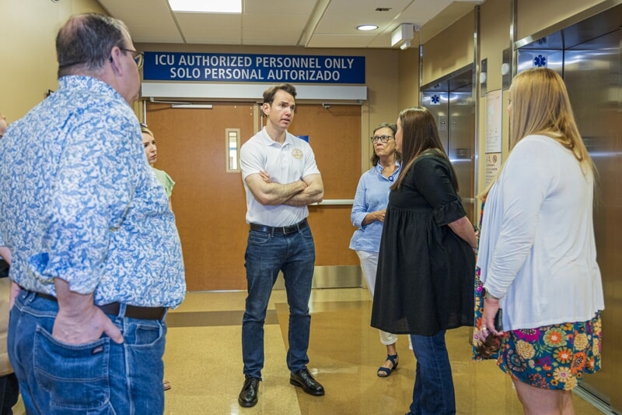Ensuring Successful Recovery Following Surgery
- Category: Blog
- Posted On:

5 Tips For a Fast & Successful Recovery After Surgery
Along with following your doctor's post-operative care instructions, there are other things that you can do to ensure a successful and quick recovery. The health experts at Northern Inyo Hospital are here share some tips to help you feel back to normal and pain-free as quickly as possible following a surgical procedure.
1. Catch Up on Your Sleep
When it comes to supporting the recovery process after surgery, the best thing you can do is relax and allow your body to recover. While it may be tempting to get back to your routine as quickly as possible, it is important to take time off from work, school, and other responsibilities to give your body the time it needs to repair itself.
Because the body does a majority of its healing while you’re sleeping, it only makes sense that getting more sleep than usual will give your body more time to recover. Along with the recommended 7-9 hours of good quality sleep each night, take naps throughout your day to supplement the recovery process.
2. Eat a Nutritious Diet
Just like most areas of your health, the foods that you eat directly affect your body’s ability to heal after surgery. Not only does eating a nutrient-dense diet help to support faster healing, it also helps your immune system to ward off infection.
As you prepare for your surgical procedure, be sure to stock your fridge and pantry with the following foods :
- Grapes
- Blueberries
- Strawberries
- Carrots
- Broccoli
- Cauliflower
- Spinach
- Brussels sprouts
- Potatoes
- Avocados
- Olive oil
- Nuts & seeds
- Kale
- Swiss chard
- Lean meats
- Eggs
- Beans & lentils
- Oranges
- Mangoes
- Tomatoes
3. Ask for Help When You Need it
Although many people fear being a burden to others, it’s important that you don’t overexert yourself after a surgical procedure. This is because it’s very possible for you to cause damage to your surgical site where there may be stitches. This could also result in injury and other post-surgical complications.
Be sure to designate a friend or family member you can call on when you’re in need of some extra help during the recovery process. You’re not a burden, you’re healing!
4. Follow Your Physical Therapist’s Instructions
Depending on the surgical procedure that you’ve had done, it’s possible that your doctor may prescribe physical therapy to help out the recovery process. This is because physical therapists will work with you to assess your current condition and create a treatment plan specific to your body and your goals.
Some of the benefits of seeing a physical therapist after a surgical procedure include:
- Improving circulation.
- Increasing mobility and improving range of motion.
- Pain management.
- Strengthening supportive muscles.
- Improving coordination.
- Injury prevention.
Remember that physical therapy is not “just exercise,”it is a prescription of exercises, stretches, and other techniques designed to help improve your musculoskeletal health. It is important for you to follow your physical therapist’s instructions and that you don’t try to try them on your own without the guidance of your PT. Your physical therapist will continue to assess your condition, adjusting your treatment as your progress.
5. Slowly Ease Back into Physical Activity
While it’s important to take it easy initially after having a surgical procedure, it’s also advised that you get up and move around to help support your body in recovery. Because this can be confusion, you may find yourself wondering how you can carefully transition back to an active lifestyle without inadvertently hurting yourself.
How Moving Around Supports Recovery
Although rest is key when it comes to recovery, getting up and moving around is also important. Staying physically active within reason can provide the following benefits:
- Supports healthy circulation.
- Improves mobility.
- Prevents future injury.
Even just getting up and walking around your house periodically can help to support the recovery process.
How to Safely Return to Activity After Your Procedure
Take it Slow
Although you may be tempted to return to your previous level of physical activity, it’s important to be realistic about the recovery process. Although returning to your previous fitness routine may be a goal you have in mind, remember to start small and slowly build up the intensity and duration of your workouts.
Start out by taking a short 15 minute walk each day, increasing your duration of your physical activity each week.
Start With Easy, Low-Impact Activities
When returning to physical activity after having had surgery, it’s important to take it easy on your joints and muscles. This helps to prevent injuries and complications with your surgical site while helping you to remain active.
Some low impact activities that you can try include:
- Swimming
- Water walking
- Yoga
- Tai chi
- Walking
- Hiking
- Gardening
Don’t Push Through the Pain
If you notice any aches and pains while you’re working out, it is very important that you don’t ignore them or try to push through the pain. Stop all physical activity and speak with your doctor if the pain you are experiencing is associated with your surgical site.
Rehabilitation Services in Bishop, CA
At Northern Inyo Healthcare District, our team of orthopedists take a holistic approach to care, focusing on you as a whole person rather than specific symptoms or conditions. We provide therapeutic services, working cooperatively with physicians, nursing staff, diagnostic imaging, environmental services, nutritional services, information technology and all hospital units – doing whatever is needed to achieve total patient care.
For more information about the rehabilitation services at Northern Inyo Healthcare District or to schedule an appointment, call (760) 873-2605.


